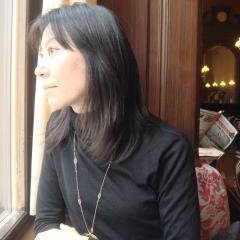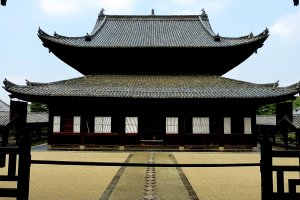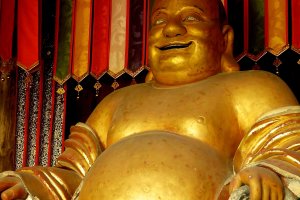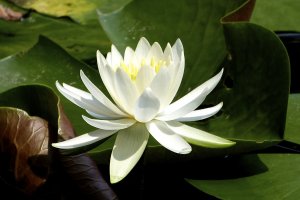Different from other Buddhist temples in Japan, priests in Manpuku-ji Temple took over the exact ways of Chinese Buddhism (the Ming style), and practice this style here even today. Their recitation voices, rhythm, and intonation of sutras sound beautiful and exotic. And the temple buildings are in the exotic Ming style, as well. The first chief priest at Manpuku-ji was a virtuous Chinese Master Priest, Ingen Ryuki, and his Zen has been an unbroken tradition here for over 350 years.
Attractive details
There are quite a few attractive colors and designs in this temple: a golden Hotei statue with colorful decorations, stone pavements designed as a dragon, extreme curved roofs, beautiful lattice, a large sand square in front of the main hall. There is also a cute fish and embroidered peach hanging in different parts of the precinct. Let me explain in more detail.
A golden Hotei statue is in Tenno-den Hall, which is the first building after passing the huge gate of Sanmon. Tenno-den is considered to be the entrance to the temple, and people first worship Hotei Buddha, and then walk toward the inner sanctuary.
In the pavements connecting some of the temple buildings, diamond-shaped stones are lined in the center, suggesting a dragon’s scale. Because a dragon is in the highest position in China, only the chief priest can place his footsteps on them.
Some of the buildings have roofs with extreme curves or beautiful lattice. These designs are traditional Chinese (Ming) style.
A large sand square called Gettai, just in front of the Daioho-den Hall, is for special rituals. They take place on the day of the new moon and full moon every month. You can see a flat stone at the center of Gettai. It is used for confessions.
A large wooden fish hanging down at the cloister is used for telling the time. Fish always swim with their eyes open, and so, it encourages the priests to be diligent. An embroidered banner with a colorful peach design is hanging at Kaizan-do Hall, which enshrines Ingen Ryuki’s spirit. Peaches are thought to be a talisman to keep evil away. This brightly colored decoration makes the room lively.
Priest Ingen Ryuki
In 1592, Ingen Ryuki was born in Fujian, Ming (Ming Dynasty 1368-1644) and was invited to Japan as a chief priest of Sofuku-ji Temple, Nagasaki in 1654. He was scheduled to stay in Japan for three years. So at the end of the third year, he was asked to come back to China repeatedly, but the Emperor and the fourth Tokugawa Shogun, Ietsuna, tried to get him to stay longer. Eventually, Ietsuna donated a huge parcel of land to Ingen, and he opened Manpuku-ji Temple in Uji, Kyoto in 1661.
When he first came to Japan, his attendants from Ming included 20 priests and 10 artisans. He and his followers worked actively, and the art, medicine, architecture, music, literature, printing technique, sencha green tea, and other culture from the Ming Dynasty took root in Japan. A green bean, now called Ingen Mame, was one of the goods he brought with him. Fucha Ryori (Chinese style vegetarian cuisine) was also introduced by him. It shows the concept that meals should be shared among companions, and be fun.
Ming Dynasty and Manpuku-ji
Priest Toko Shinetsu (See the related article on Daio-ji Temple), who was also originally from Ming, visited Manpuku-ji in 1680. According to the book (『明朝末帝の日本亡命』), he knew a secret story about the last emperor of the Ming Dynasty at that time. The story was as follows:
In 1647 three Chinese ships suddenly appeared and anchored off the coast of Nagasaki. Tokugawa Shogunate investigated the ships, preparing his troops for action. Surprisingly they found 360 people including a noble personage from Ming on the ships. They were refugees, fleeing from the newly established Qing Dynasty, and asked Japan for protection. The Shogunate accepted their request, and secretly sheltered the noble personage and his family. But the other people were deported. The noble family was finally taken into the Owari clan and resided in Japan thereafter. But for a while after coming to Japan, he often visited Manpuku-ji's Itokuden (the inner most place of the temple) to have secret meetings aimed at restoring his dynasty once again. But this didn’t happen, as history shows.
Manpuku-ji is a very unique temple, which keeps the manners and style of the Ming Dynasty. Unfortunately, most of the Buddhist temples in China and especially the Ming temples have already been lost, but here in Japan we can feel and touch their customs, beliefs, art, and style. Priest Ingen’s Zen and his spirit have been kept alive here. You can slip back to Ming, China, with a 20-minute ride on the JR Nara Line from Kyoto. Get off at Obaku Station.

































